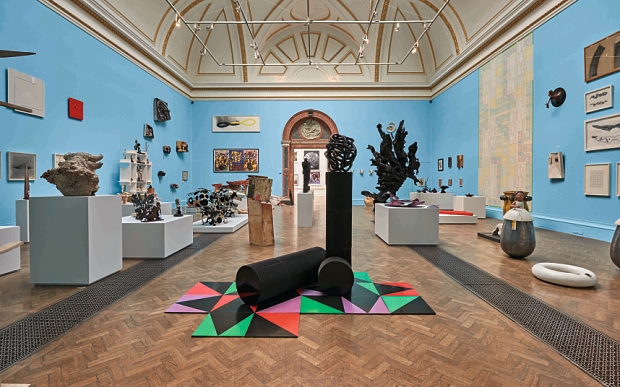The Royal Academy Summer Exhibition has very little in common with the Venice Biennale. However they do share one characteristic. Each always contains so many diverse and potentially incompatible elements that orchestrating a smoothly blended result is dauntingly difficult. But, as with many almost impossible tasks, some manage it much better than others. Michael Craig-Martin, this year’s chief co-ordinator at the RA, has produced a distinctly better result than usual.
The Summer Exhibition always tends to look — as David Hockney once put it — like a jumble sale. But the 2015 edition is a jumble sale with pizzazz and a chromatic zing. The transformation begins before you even get into the exhibition. The grand staircase at Burlington House has been covered in the brilliantly coloured stripes of one of Jim Lambie’s ‘Zobop’ floors (in which strips of glossy tape follow the lines of the architecture). Perhaps the academicians ought to keep it.
When you walk into the octagonal entrance gallery, your first impression is that he’s transformed the place into one gigantic Craig-Martin. The walls of this room have been painted in one of his trademark colours, a vivid greenish-blue (every painter has a distinctive range of hues; Craig-Martin’s has the acid sharpness of cheap sweets). Against this background, one work — appropriately enough by the current president of the Academy, Christopher Le Brun — sings out.
Freely painted and abstract in yellow and orange, this is not like any work by him I have seen before; in this context it looks terrific. Abstraction, it turns out, is one of the outstanding categories of art this year. It dominates Gallery III next door, which Craig-Martin has decorated in a marvellous teenager’s-plastic-handbag pink. Hanging on this is a succession of large-scale works that are less crammed together than is customary at the Summer Exhibition.
Among those that catch, and hold, the eye is ‘Mississippi River Blues’, a gigantic print by Richard Long. True, this could be categorised as utterly naturalistic rather than abstract, since it documents a liquid flow and spatter — like muddy river water — down the surface. Frank Bowling — a senior painter who deserves a full retrospective — scores too with ‘Pickerslift’, a joyous exercise in poured, dripping, caked and mottled pigment. Gallery III, the heart of any RA show, is the most satisfactory in this Summer Exhibition.
In the figurative department, this gallery contains a fine ‘Tree No 7’ by Tony Bevan, with twigs like arthritic fingers. The Craig-Martin touch is evident in other parts of the exhibition (but not all, as some galleries were hung by other academicians). He has invited several artists to participate, using the quirky but engaging criteria that they should be artists who don’t usually take part, that he should admire their work and — an anti-ageist stipulation — that they should be over 65.
Among this pension-age contingent, Alan Charlton stands out with an elegant grey ‘Triangle Painting’ in Gallery VI, which is exactly what the title says; a three-sided shaped canvas. This is the kind of picture that is morphing into sculpture: a flat object on the wall. Scattered around there are a number of show-stopping sculptures, but it isn’t the ones in the main sculpture gallery, the Lecture Room, that do best. As is often the case, this houses a dense crowd of dissimilar three-dimensional works, all upstaging one another.
Outside in the courtyard, Conrad Shawcross has created a sort of geometric woodland: a thicket of tetrahedrons on metal trunks, through which the bronze statue of Joshua Reynolds seems to be pushing its way. Elsewhere, Rebecca Warren’s ‘Long Ago and So Far Away’ — an object somewhere between a Giacometti and a long, thin, very well licked ice cream — pulls the eye away from a whole gallery of pictures. Another gallery is dominated by Stephen Cox’s three monoliths – all entitled ‘Bek’: slabs of Egyptian alabaster, just undulating enough to suggest the curves of a human body. A third is filled, or so at least it seems, by David Nash’s ‘Cork Dome’, a mound made up of curving sections of bark.
Craig-Martin has set aside a couple of rooms as one-artist mini-exhibitions. One of these is by the South African William Kentridge, who is exhibiting a series of ink drawings of trees, the leaves and branches of which are drawn over pages cut from dictionaries and encyclopedias (doubtless made of wood pulp). Over these are written words and phrases: ‘smoke’, ‘gibbet’, ‘ash’ on one. It amounts to a meditation on trees — which are, perhaps accidentally, a sub-theme of the show.
Such connections can only bind together the Summer Exhibition to a limited extent, because its nature is to be chaotically random. Many heterogeneous ingredients simply have to be included, because all the academicians are entitled to show work. The result is, in art-viewing terms, the equivalent of the coelacanth. That is, a living fossil — a mid-18th-century institution that somehow survives and thrives in the modern world.
If a curator, as Craig-Martin has on this occasion, imposes a degree of contemporary style order in one place — a sparer hang, a restriction on items that have qualities in common — then anarchy breaks out somewhere else. There are still rooms where Reynolds and Gainsborough would recognise the dense massing of pictures over the walls. That’s part of the fun, I suppose. Nonetheless — call me a neophiliac, if you like — I tend to enjoy it most when some 21st-century order has been brought to the primordial jumble.






Comments